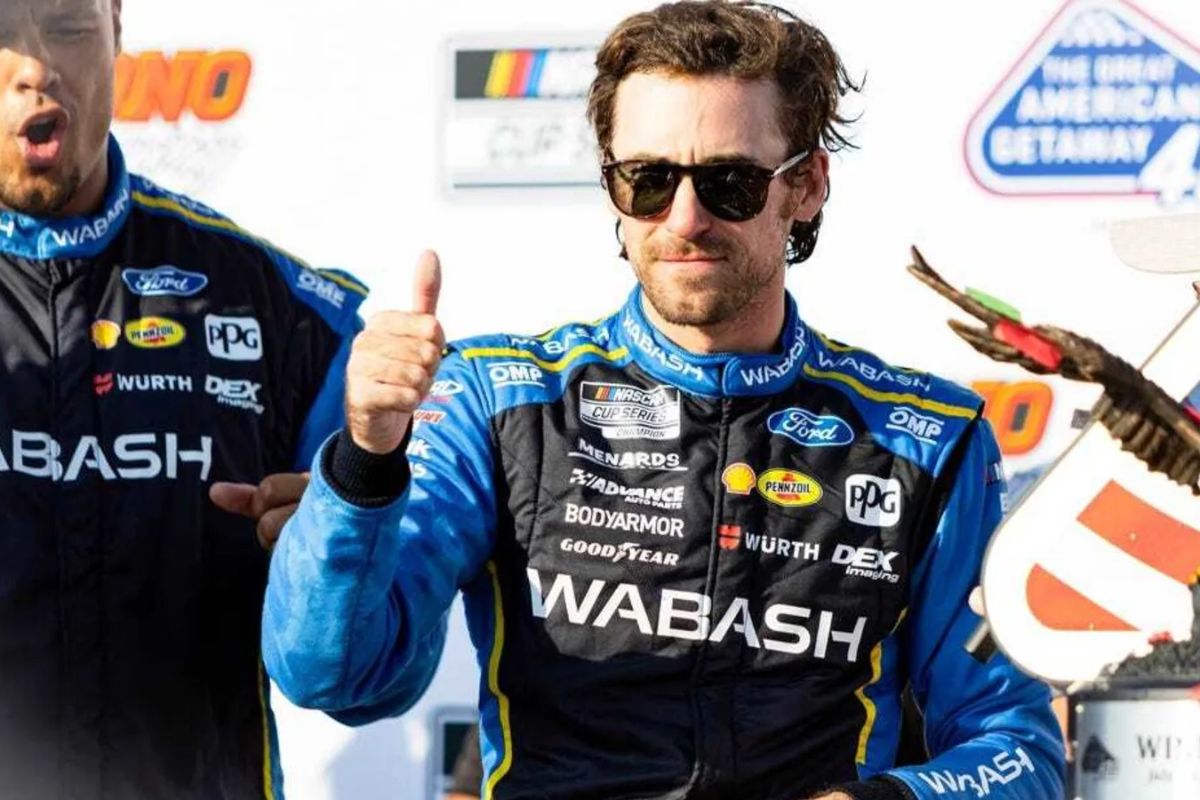Ryan Blaney Shares What True Racing Success Means in NASCAR: In a recent interview, Ryan Blaney articulates a nuanced perspective on racing success in NASCAR, one that extends beyond the confines of skill and performance. He suggests that a driver’s reputation is profoundly influenced by public perception, where character and integrity play pivotal roles. This raises critical questions about the relationship between on-track achievements and the respect earned off the track. As Blaney navigates this intricate landscape, it becomes apparent that the true essence of success in NASCAR might not be as straightforward as it seems, inviting further exploration into how judgment shapes a driver’s legacy.
Key Highlights
- Ryan Blaney defines true racing success as a combination of skill, strategy, and the ability to adapt to changing circumstances.
- Success is not solely about driving talent but also encompasses personal character and the ability to influence positively off the track.
- Consistent performance over time, including championship wins, shapes public perception and long-term success in NASCAR.
- Teamwork and collaboration with crew members are crucial for achieving optimal race outcomes and individual success.
Ryan Blaney’s Views on Success
Ryan Blaney articulates that success in NASCAR is not merely defined by victories but is a culmination of resilience, teamwork, and continuous adaptation to the changing challenges of the sport. His perspective reflects a profound understanding of the multifaceted nature of racing, which transcends the simplistic view of winning races. Blaney highlights that each race presents unique obstacles that require drivers and teams to recalibrate strategies, showcasing the importance of adaptability in a landscape where variables are in constant flux.
In his seventh season with Team Penske, Blaney’s achievements—including 12 Cup race wins—are a demonstration of his commitment to honing his skills and fostering synergy with his crew. This partnership emphasizes the critical role of teamwork in NASCAR, where the collective efforts of the driver, pit crew, and strategists can greatly influence the outcome of a race. Blaney’s insights reveal that true success is not solely measured by trophies but by the ability to confront challenges head-on, learn from setbacks, and cultivate an environment of mutual support.
Moreover, Blaney’s victory at the 2022 NASCAR All-Star race exemplifies the grit required to thrive in this demanding sport. Such moments of triumph are built on a foundation of preparation, perseverance, and the willingness to evolve continually. In an arena where public perception often simplifies success to mere numbers, Blaney’s philosophy serves as a reminder that the experience is as crucial as the destination, inviting aspiring drivers to appreciate the intricate tapestry that defines NASCAR excellence.
Exclusive Interview with The Athletic
In an exclusive interview with The Athletic, Blaney shared his evolved perspective on measuring success in NASCAR, emphasizing the importance of both driving talent and personal character. As he reflects on his expedition, Blaney articulates a nuanced understanding that transcends mere victories. He posits that a driver’s worth is not solely contingent upon their performance on the track but also on their demeanor and influence off it.
Blaney’s insights reveal a notable shift in his mindset as he matures within the sport. He encourages aspiring drivers and fans alike to ponder the multifaceted nature of success. ‘I try to put myself in a car owner standpoint,’ he explains, underscoring the critical evaluation criteria that go beyond raw speed and racecraft. The essence of his argument lies in the acknowledgment that a driver’s character shapes public perception and contributes to their legacy.
“I’ve gotten a better grasp on this as I’ve gotten older. … I try to put myself in a car owner standpoint, like how do you look at a driver? Is it how talented they are behind the wheel? How much speed do they have? How is their racecraft?” – Blaney
Moreover, Blaney stresses the importance of being a positive role model. He recognizes that his actions and demeanor resonate with fans, particularly young individuals who idolize athletes. This awareness fosters a sense of responsibility, pushing him to embody qualities that inspire rather than merely entertain.
“And then it’s, what are you like as a person? People judge you a lot on that. Are you good to your followers and fans who support you? What are you like as a role model to young kids who look up to you? Those are the things I try to look at and mold myself after.” – Blaney
In a competitive arena where judgment is swift and often harsh, Blaney’s perspective invites a broader dialogue about the values that should underpin success in sports. His reflections serve as a reminder that true accomplishment in NASCAR is as much about integrity and influence as it is about crossing the finish line initially.
Current Standings and Season Performance
At this juncture in the season, Blaney’s impressive performance has positioned him fifth in the driver standings. His two victories, particularly at The Great American Getaway 400 at Pocono Raceway, reflect not only his skill but also his tactical insight in maneuvering through the challenges of each race. With 11 top-10 finishes and seven top-five placements, Blaney has illustrated a remarkable blend of speed and reliability, crucial traits for any contender in the NASCAR circuit.
As the playoffs loom, securing a spot in this competitive environment is a reflection of his perseverance and determination. The two-week hiatus due to the upcoming 2024 Paris Olympics provides a tactical pause for Blaney and his team to recalibrate and strengthen their approach. This break can serve as an opportunity to analyze performance data, refine their strategies, and improve the car’s setup to guarantee they remain formidable contenders.
Blaney’s current standing is not merely a number; it reflects a season marked by resilience and adaptability. Each race adds layers to his experience, equipping him with insights that can be pivotal as he aims to defend his title. The competitive landscape of NASCAR is unforgiving, and maintaining momentum through the remainder of the season will be critical. Consequently, Blaney’s focus on continuous improvement and tactical execution could very well define his path in the upcoming playoff rounds.
Kevin Harvick on Kyle Larson’s Overtime Restart
Kevin Harvick offers a critical perspective on the controversial overtime restart at the Brickyard 400, where Kyle Larson’s tactical maneuvering allowed him to seize victory from an unsuspecting Ryan Blaney. The incident has not only ignited debates among fans and analysts alike but has also raised questions about the ethics of racing strategy in high-stakes situations.
- Larson’s positioning at the restart presented a unique opportunity.
- The green flag waved while Brad Keselowski was still on pit road.
- Blaney, in P2, was left at a disadvantage due to the unexpected timing.
- Speculation arose regarding whether Larson jumped the start.
Harvick’s comments reflect a broader concern about the integrity of racing in NASCAR, particularly when pivotal moments can pivot on the interpretation of rules. The dynamics of the restart seemed to favor Larson, who capitalized on a situation that many felt was less about skill and more about timing and luck.
“The restart was tight. I went back and watched it a couple of times. I don’t see anything that I would call a penalty or Larson jumping the start. I think they just took off about the same time, and he just beat Blaney through the gears, it looked like to me.” – Harvick

Furthermore, Harvick’s insights call for a reassessment of how such critical situations are governed. The controversy surrounding Larson’s actions could serve as a catalyst for discussions about the necessity of stricter regulations or clearer guidelines for overtime restarts.
Analysis of the Restart Incident
The overtime restart incident at the Brickyard 400 serves as a focal point for examining the intricate dynamics of racing strategy, particularly in the context of competitive advantages and the interpretation of rules that can dramatically influence race outcomes.
The discussion surrounding this incident highlights the nuances of timing and positioning during restarts, which can often be pivotal in determining a driver’s success.
Kevin Harvick’s assessment of the restart suggests that Kyle Larson’s maneuver was not a violation but rather a matter of execution under pressure. With Larson benefiting from fresher tires, the SMT data indicating that Ryan Blaney was in third gear before the restart presents an interesting angle.
This detail emphasizes the importance of gear selection and throttle application as critical factors in gaining an edge off the line. A driver’s ability to react swiftly to the green flag can be the difference between seizing an opportunity or falling behind.
Blaney’s eventual P3 finish, while commendable, reflects the broader implications of such incidents on perceptions of fairness and tactical insight in racing. The incident serves as a reminder that in NASCAR, the lines between competitive advantage and rule interpretation can often blur, leading to debates among drivers and fans alike.
News in Brief: Ryan Blaney Shares What True Racing Success Means in NASCAR
Ryan Blaney’s perspective on racing success in NASCAR highlights the intricate relationship between performance and public perception.
The emphasis on character, resilience, and integrity underscores the notion that a driver’s reputation is shaped not only by on-track achievements but also by off-track behavior.
This holistic view of success challenges the traditional metrics of performance, suggesting that the legacy of a driver is ultimately defined by their impact on fans and peers alike.
ALSO READ: Ryan Blaney Welcomes NASCAR in the Olympics Under Unique Conditions



